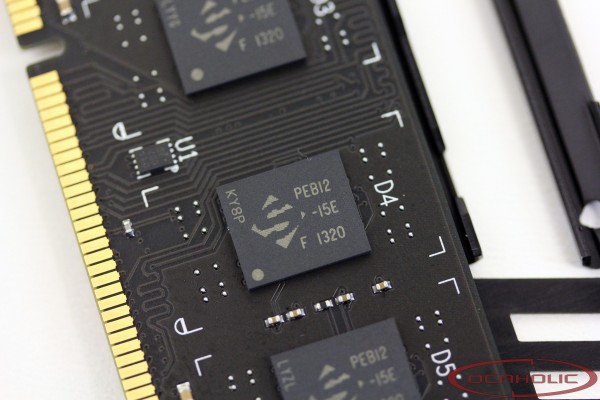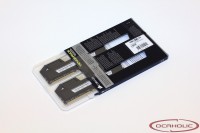
Corsair Vengeance Pro 2x8GB DDR3-1866 CL9 1.5V Review
Category : DDR3
Published by Sam on 01.10.13
 Since bright sun and hot weather are not the sort of things us nerds usually like, let us grab some cold beer and retrieve to our shady hideout for another ride into the world of desktop memory. On today’s menu we have a 2x8GB set of Corsair Vengeance Pro that carries a spec of DDR3-1866 CL9.
Since bright sun and hot weather are not the sort of things us nerds usually like, let us grab some cold beer and retrieve to our shady hideout for another ride into the world of desktop memory. On today’s menu we have a 2x8GB set of Corsair Vengeance Pro that carries a spec of DDR3-1866 CL9.
 Article in English Article in English |
 Artikel in Deutsch Artikel in Deutsch |
 Article en français Article en français |
 Articolo in italiano Articolo in italiano |
| Manufacturer | Corsair |
| Series | Vengeance Pro |
| Part Number | CMY16GX3M2A1866C9 |
| Type | DDR3 |
| Capacity | 16 GB (2 x 8GB) |
| Frequency | 933 MHz (DDR3-1866) |
| Timings | 9-10-9-27 |
| VDIMM | 1.5 Volt |
| Registred/Unbuffered | Unbuffered |
| ECC | No |
| Cooling | Passive Heatspreader |
| Waranty | Lifetime warranty |
| Package Type | Boxed |
Getting memory to work on Haswell platform is no harder compared to any other, nevertheless, this didn’t hold Corsair from generating yet another branch in their product lineup, the Vengeance Pro series, that are meant to be LGA1150-compatible from the very beginning.
Looking at the version number (ver3.24) on our sample, we see that it is based on Micron memory chips rather than more common Hynix or Samsung. After recent takeover of Elpida, Micron didn’t enjoy much success on high-density overclocking scene, but, as new generations of memory chips usually release without drawing too much attention, we might be in for a surprise on page four of this review.
For now, let us recall the module appearance.
| Page 1 - Introduction |
| Page 2 - Closer Look |
| Page 3 - Photo Gallery |
| Page 4 - Results |
| Page 5 - Conclusion |
Closer Look
As common with Corsair’s mid-range products, the memory is shipped in a compact box that broadcasts some multi-language marketing points along the way.Vengeance Pro comes in four different color modifications – blue, gold, red and silver, the latter of which we actually have. With all the different motherboard color schemes floating around, silver could be the safest bet as black motherboard PCB and aluminium/nickel-plated heatsink are the scenery you are most likely to have around the memory area.
Technically, each 8GB module of Vengeance Pro is a piece of standard-height black PCB with eight memory chips on either of its sides that are covered by a part-time styling feature, part-time heatspreaders made out of thin aluminium.
Gripping on only by a strip of relatively weak thermal tape, heatsinks can be taken off without any fight or warranty seals to worry about. As predicted on the previous page, this version of the Vengeance Pro is based on memory chips manufactured by Micron. Sadly, we couldn’t detect the exact model of chips is use as those on our own kit are covered by what appears to be a SpecTek marking.

SPD module on the Vengeance Pro provides some basic information on the maker and the model of the memory. It also features four JEDEC profiles up to DDR3-1333 and an XMP with specs that are there to make sure users won’t need to fiddle with the subsettings to get the memory to work.
| Page 1 - Introduction |
| Page 2 - Closer Look |
| Page 3 - Photo Gallery |
| Page 4 - Results |
| Page 5 - Conclusion |
Photo Gallery
| Page 1 - Introduction |
| Page 2 - Closer Look |
| Page 3 - Photo Gallery |
| Page 4 - Results |
| Page 5 - Conclusion |
Testing Method & Test Setup
To test the overclocking capabilities of the memory we are going to use Intel’s recently released Haswell platform. As memory overclocks are known to vary between different motherboards, we are going to perform the tests using two different platforms to be sure that our numbers are reliable.| Motherboard | ASUS Maximus VI Gene (BIOS 0607) Gigabyte Z87X-OC (BIOS F5s) |
| CPU | Intel Core i7-4770K ES @ 4.0 GHz |
| Graphic card | ASUS GTX 580 |
| Memory | Corsair Vengeance Pro CMY16GX3M2A1866C9 |
| SSD | Samsung PM840 Pro |
| PSU | Seasonic Platinum 660 Watts |
| OS | Windows 7, 64 bit SP1 |
Even though Haswell is very flexible on the memory frequency one can set, very few people actually do base clock (BCLK) overclocking on their daily setups. Therefore, instead of our previous procedure of fixing the voltage and raising the frequency in 10MHz steps we are now going to fix the frequency and minimize the voltage in 0.01V steps.
As usual, our stability method of choice is HCI Memtest. Since we are dealing with an 16 GB kit, we use eight 1500 MB instances and call things stable if we see all of them to go past 100% without showing a single error.
Not to get things too complicated, we only set the primary timings, command rate (1T) and the memory voltage by hand while the rest of the settings is left for the motherboard and SPD to agree on.
Results
As we were dealing with memory based on chips we might not have had before, we had to start from scratch, i.e. try every possible timing combination. After some time, we managed to narrow things down to eight timing combinations that made most sense. Also, we discovered that maximum stable frequency is a function of voltage, but whereas Micron chips of the older days could scale up to 2.0V with ease, these new ones were already having stability issues running at 1.8V.
In the end, we were able to get the memory running at DDR3-2000 with 8-9-10-24 and DDR3-2200 with 9-9-10-27, both times without exceeding a psychological voltage barrier of 1.65V. We could also achieve stability at 1200MHz, a.k.a. DDR3-2400 but doing so required loosening up the timings and pushing the voltage past 1.7V so it might not be the best thing to do from a daily user’s perspective.
| Page 1 - Introduction |
| Page 2 - Closer Look |
| Page 3 - Photo Gallery |
| Page 4 - Results |
| Page 5 - Conclusion |
Conclusion
Using geizhals as our price research tool, we see the offers for CMY16GX3M2A1866C9 starting at 129 Euros excluding shipping across the EU. This turns the Vengeance Pro into yet another kit that is outpriced by Caseking’s current TeamGroup DDR3-2400 CL10 offer. Even in their own DDR3-1866 CL9 category, the Vengeance are not the cheapest of available options, which once again raises the individual question whether products with fancy brand names are worth the extra investment.Overall, the 16GB version of 1866C9 Vengeance Pro is not a tragedy, but it’s no brilliant either. What Corsair have managed to come up with here is a product without any particular strong nor weak points that is ready to join the masses of other (literally) grey middle-end memory on the market.
Award
The 2x8GB kit of Corsair Vengeance Pro DDR3-1866 CL9 gets an ocaholic rating of 3.5 stars out of 5.
| Page 1 - Introduction |
| Page 2 - Closer Look |
| Page 3 - Photo Gallery |
| Page 4 - Results |
| Page 5 - Conclusion |















